Basic Needs | Social Science Olympiad for Class 3 PDF Download
Basic Needs
Basic needs are the most important things that everyone must have to live a good life. They include food, water, shelter (a safe place to live),and clothes. These things keep us happy and healthy. Let’s learn about all of them one by one:
Food
Food is what we eat to give our bodies the energy and nutrients they need to work properly. It's like fuel for our bodies, just like how a car needs gas to run.
There are many different kinds of foods, and they can be grouped into different categories. Let's talk about some common types:
Fruits: These are sweet or sometimes tangy foods that come from plants. Examples include apples, bananas, oranges, and strawberries.
Vegetables: These are plant-based foods that are often colorful and rich in vitamins and minerals. Examples are carrots, broccoli, spinach, and tomatoes.
Grains: These foods come from plants and include things like rice, bread, pasta, and oats. They give us energy.
Proteins: These foods help our muscles grow strong. Examples are meat (like chicken or beef), fish, eggs, nuts, and beans.
Dairy: These foods come from milk, and they are good for our bones and teeth. Examples are milk, cheese, and yogurt.
Sweets and Snacks: These are treats that are usually sweet or salty. Examples include cookies, candies, chips, and ice cream. While it's fun to enjoy them sometimes, it's essential to eat them in moderation.
Spices: Spices are special ingredients that we use to add flavor, aroma, and sometimes color to our food. They come from various parts of plants, like seeds, bark, roots, or dried fruits. People have been using spices for thousands of years to make their food more interesting and tasty.
Spices commonly found in India:

Famous foods in India
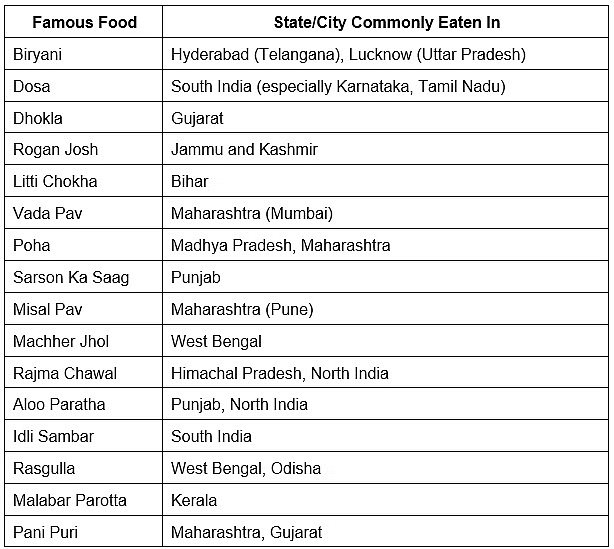
Commonly Consumed Raw foods in India

Nutrient we get from food:
Food provides us with various nutrients that our bodies need to function properly and stay healthy. Here are some essential nutrients we get from food:
- Carbohydrates: These are the body's primary source of energy. Foods like bread, rice, pasta, and fruits are rich in carbohydrates.
- Proteins: Proteins are crucial for building and repairing tissues in our body. Meats, fish, eggs, dairy products, beans, and nuts are good sources of protein.
- Fats: Fats are also an energy source and are important for absorbing certain vitamins. Avocados, nuts, olive oil, and fatty fish are examples of foods high in healthy fats.
- Vitamins: Different vitamins play various roles in keeping us healthy. For example, vitamin C in fruits helps our immune system, while vitamin A in vegetables is essential for good vision.
- Minerals: Minerals, like calcium, iron, and potassium, are important for various functions such as bone health, blood formation, and maintaining electrolyte balance. Dairy products, leafy greens, and lean meats are good sources.
- Fiber: Found in fruits, vegetables, and whole grains, fiber is essential for a healthy digestive system. It helps prevent constipation and supports overall gut health.
- Water: While not a nutrient, water is vital for our survival. It helps with digestion, regulates body temperature, and is involved in many bodily processes.
Eating a variety of foods from different groups helps ensure that you get a good mix of these nutrients, keeping your body strong and healthy.
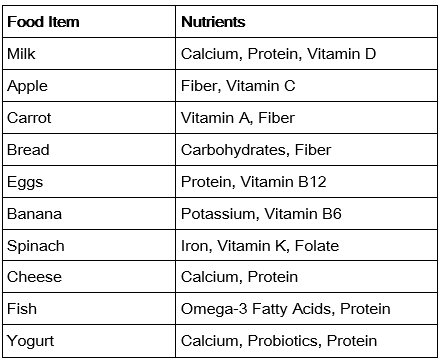
Clothes
Clothes are like a cozy, protective layer we put on our bodies. They have a few important jobs:
- Keep Us Warm: When it's chilly outside, clothes help us stay warm. Think of your jackets, sweaters, and hats – they act like a cozy blanket for your body.
- Protect Our Skin: Clothes also shield our skin from the sun, wind, and other things that might not feel so good. Just like armor, but much softer!
- Express Our Style: Clothes can show off our personality and style. Some people like bright colors, some like patterns, and others prefer simple and plain. It's a bit like wearing your favorite colors or characters.
- Cover Our Bodies: Clothes provide privacy by covering our bodies. They help us feel comfortable and confident when we're around other people.
- Adapt to the Weather: Depending on the weather, we wear different clothes. In hot weather, we might wear shorts and T-shirts, while in cold weather, we bundle up with layers and warm coats.
So, clothes are like our second skin that we choose to wear every day, making us feel comfortable, protected, and expressing our own unique style!
Different Types of Clothes:
Cotton:
- We wear cotton clothes in summer. They are lightweight and breathable, making them ideal for hot weather.
Woolen:
- Woolen clothes are worn in winter to provide insulation and warmth in cold weather.
Denim:
- Denim is versatile and can be worn throughout the year for various occasions.
Nylon:
- Nylon clothes are quick-drying and water-resistant, making them suitable for rainy days.
Linen:
- Linen is a lightweight and breathable fabric, perfect for hot and humid weather.
Leather:
- Leather provides warmth and protection from cold winds during the colder seasons.
Polyester:
- Polyester is a versatile fabric commonly used in various types of clothing.
Silk:
- Silk is smooth and luxurious, making it suitable for special events and warm weather.
Flannel:
- Flannel is soft and warm, often used in shirts and pajamas for colder seasons.
Synthetic Fabrics (e.g., Spandex, Lycra):
- Synthetic fabrics like Spandex and Lycra are stretchy and comfortable, suitable for physical activities.
Traditional Clothes of different States in India:
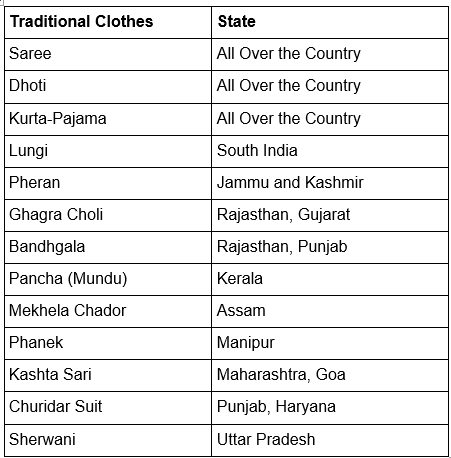
Shelter
Shelter is a safe and protected place where people and animals live or take refuge. It provides a home, a space to stay warm and dry, and a secure environment. Humans and many animals need shelter for various reasons:
- Protection from Weather: Shelter shields us from harsh weather conditions like rain, snow, wind, and extreme temperatures. It keeps us comfortable and safe.
- Safety and Security: A shelter provides a secure space, protecting us from potential dangers and providing a sense of safety.
- Privacy: Shelter offers a private space where individuals or families can have personal and intimate moments away from the public eye.
- Storage: It is a place to store belongings and possessions, keeping them safe from theft or damage.
- Rest and Sleep: Shelter provides a place to rest, relax, and sleep, allowing individuals to recharge and be ready for the next day.
- Shelters can come in various forms, such as houses, apartments, huts, tents, or even dens for animals. The type of shelter can depend on factors like climate, culture, and available resources. Overall, shelter is a fundamental need for living a safe, comfortable, and fulfilling life.
What is a House
A house is a place where people live. It's like a big box with rooms inside. Each room has a job – one is for sleeping, one for cooking, and another for watching TV. The roof on top keeps rain and sun out. Walls are like big dividers, and doors and windows help you get in and let light and air inside. The floor is where you walk, and the yard is the space outside. It's your own special place to be comfy and safe.
Types of Houses
Permanent Houses
- Permanent houses are constructed to endure over an extended period, characterized by strength and durability, utilizing materials such as bricks, cement, and iron.
- Residents of permanent houses typically remain in the same place for an extended duration.
- These dwellings offer a feeling of stability and are engineered to withstand diverse weather conditions.
- Equipped with essential amenities, permanent houses feature rooms, bathrooms, kitchens, and facilities to ensure comfortable living.
- Varieties of permanent houses encompass flats, bungalows, and villas.
Temporary Houses
- Temporary houses are crafted for effortless relocation, allowing easy movement from one location to another.
- The purpose of temporary houses is not to establish a long-term presence in a single place.
- Inhabitants of temporary houses often experience frequent moves or require a flexible living arrangement.
- Tent, yurts, camper vans, caravans, and houseboats are instances of temporary housing options.
Special Houses
Special houses stand out as distinct and diverge from the conventional residences we encounter regularly. Typically, these houses are constructed to fulfill particular requirements or to conform to unique surroundings. A few illustrations of special houses include:
Stilt House: This type of dwelling is erected on elevated wooden poles or pillars. It is commonly observed in regions susceptible to flooding, serving as a protective measure against rising water levels.
Houseboat: A houseboat is a residence that floats on lakes, rivers, or canals, providing a distinctive lifestyle on the water equipped with essential comforts. Additionally, it serves as an illustration of a temporary dwelling.
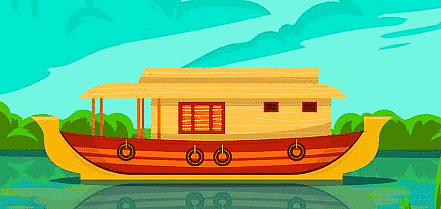
Lighthouse: Typically situated near coastlines, a lighthouse is a lofty tower-like structure designed to function as a navigational guide for ships and boats. In certain instances, it includes accommodations for the lighthouse keepers.

Igloo: Constructed in extremely cold regions, an igloo is a dwelling crafted from blocks of ice or densely packed snow, offering insulation against the frigid temperatures of the surrounding environment.
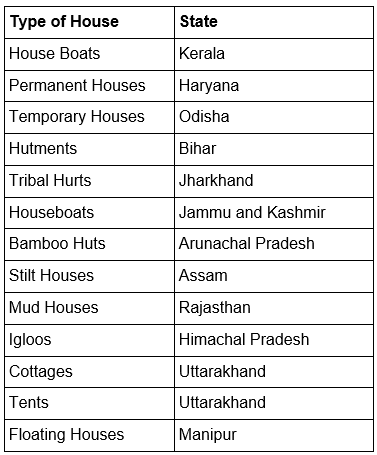
|
15 videos|16 docs|27 tests
|
FAQs on Basic Needs - Social Science Olympiad for Class 3
| 1. What are considered basic clothing needs? |  |
| 2. How can someone in need access free or low-cost clothing? |  |
| 3. How can someone donate clothing to those in need? |  |
| 4. What should be considered when selecting clothing donations for those in need? |  |
| 5. How can communities support individuals in need of clothing assistance? |  |





















